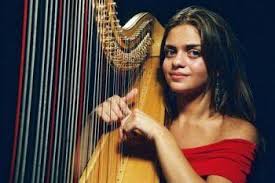St Clements Church, 15 11 14
It is not often a solo harp is required for a choral work, and the presentation of Saint-Saens’ little known Oratorio de Noel not only brought us the superb playing of Cecilia Sultana de Maria but the added benefit of Debussy’s Danses Sacree et Profane. This work opened the evening, the gentle line of the solo harp carrying easily in the new acoustic of St Clements. The strings of Ensemble OrQuesta were equally impressive and the whole eased us into an evening of lesser known masterpieces.
Saint-Saens was only 23 when he composed the Oratorio de Noel but is has all the romantic nuances we associate with his more mature compositions. There are many hints of Berlioz here, particularly in the choral writing, which was performed with precision and panache. Originally written for solo organ and harp, the organ writing is far more than a simple continuo and was played with considerable subtlety and apt registration by Robert Leach.
Arvo Part’s Berlin Mass dates from 1990 and is well within the range of a well-trained choir, even if it at times may challenge an audience more used to romantic lyricism. The Gloria comes in a succession of billowing waves of sound and the Credo has the staccato attack of early Stravinsky. The lovely Sanctus, set for lower voices, is reverential rather than ecstatic, and very moving.
By contrast, Mozart’s Solemn Vespers of 1779 was the least spiritual piece of the evening, its heady operatic style and ornamentation being a world away from the sensitivity of Saint-Saens and Part. The choir, who had sang so well in the earlier works, seemed less at ease here and some of the exposed lines were a little raw.
Four young singers provided all the solo parts with particularly impressive contributions from mezzo-soprano Rozanna Madylus and baritone Dominic Sedgewick.
With so much that was so good it seems uncharitable to point to problems with the evening, both of which were obviously out of the control of the performers. The programme gave solid background information but no sense of the text we were hearing. This was not such a problem for the Part and Mozart, where the mass setting is familiar to most, but the Saint-Saens was effectively incomprehensible. The other problem was the large amount of noise at the back and side of the church with late arrivals and refreshments. Anyone further away than the first few rows would have been acutely aware of the interruption to the gentle opening of the Debussy.
Marcio da Silva has made a real impact on the musical life of Hastings and his choice of works was vindicated last night not only in the high quality he creates but the very large audience he attracts. Long may it continue!
The Christmas Concert will be, as usual, at St Mary in the Castle at 5.00pm on 20 December.

